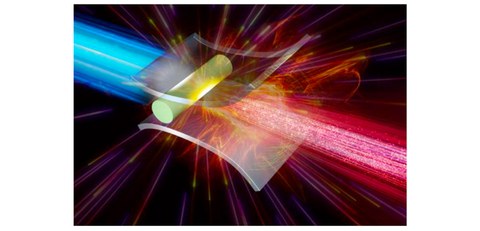
Tabletop particle blaster: How tiny nozzles and lasers could replace giant accelerators
Researchers at The University of Osaka have proposed "micronozzle acceleration"—a novel method for generating giga-electron-volt proton beams using ultra-intense lasers.
Proton beams with giga-electron-volt (GeV) energies—once thought to be achievable only with massive particle accelerators—may soon be generated in compact setups thanks to a breakthrough by researchers at The University of Osaka.
A team led by Professor Masakatsu Murakami has developed a novel concept called micronozzle acceleration (MNA). By designing a microtarget with tiny nozzle-like features and irradiating it with ultraintense, ultrashort laser pulses, the team successfully demonstrated—through advanced numerical simulations—the generation of high-quality, GeV-class proton beams: a world-first achievement.
Unlike traditional laser-based acceleration methods that use flat targets and reach energy limits below 100 mega-electron-volt (MeV) (1 GeV = 1000 MeV), the micronozzle structure enables sustained, stepwise acceleration of protons within a powerful quasi-static electric field created inside the target. This new mechanism allows proton energies to exceed 1 GeV, with excellent beam quality and stability.
“This discovery opens a new door for compact, high-efficiency particle acceleration,” says Prof. Murakami. “We believe this method has the potential to revolutionize fields such as laser fusion energy, advanced radiotherapy, and even laboratory-scale astrophysics.”
The implications are wide-reaching:
- Energy: Supports fast ignition schemes in laser-driven nuclear fusion.
- Medicine: Enables more compact and precise systems for proton cancer therapy.
- Fundamental Science: Creates conditions to simulate extreme astrophysical environments and probe matter under ultra-strong magnetic fields.
The study, based on simulations performed on the SQUID supercomputer at The University of Osaka, marks the first-ever theoretical demonstration of compact GeV proton acceleration using microstructured targets.
Fig .1
Conceptual illustration of micronozzle acceleration (MNA).
A solid hydrogen rod is embedded in an aluminum micronozzle, which channels and focuses plasma flow to optimize proton acceleration.
Credit: Masakatsu Murakami
Fig. 2
Concept of Micronozzle Acceleration (MNA).
The MNA (Micro-Nozzle Acceleration) target employs a micronozzle housing a solid hydrogen rod (H-rod), precisely placed near the nozzle neck to maximize proton yield. Acting as a "power lens," the micronozzle focuses the incident laser energy onto the H-rod, enabling efficient and localized energy deposition. This configuration significantly boosts proton acceleration near the nozzle exit, outperforming setups lacking the nozzle structure.
Credit: 2025, Masakatsu Murakami, et al., Generation of giga-electron-volt proton beams by micronozzle acceleration, Scientific Reports
The article, “Generation of giga-electron-volt proton beams by micronozzle acceleration,” was published in Scientific Reports at DOI: https://doi.org/10.1038/s41598-025-03385-x
